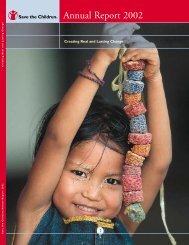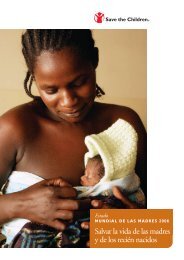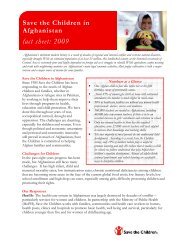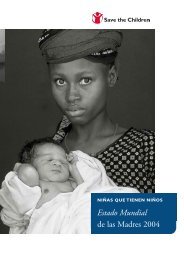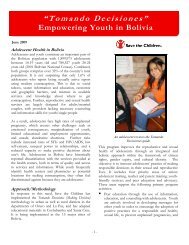The Power and Promise of Girls' Education - Save the Children
The Power and Promise of Girls' Education - Save the Children
The Power and Promise of Girls' Education - Save the Children
You also want an ePaper? Increase the reach of your titles
YUMPU automatically turns print PDFs into web optimized ePapers that Google loves.
<strong>The</strong> lack <strong>of</strong> access to education <strong>and</strong> basic services, as<br />
well as <strong>the</strong> emotional trauma <strong>of</strong> disasters, takes an<br />
enormous toll on all children.<br />
Experts have noted that girls dropping out <strong>of</strong> school is<br />
<strong>of</strong>ten one <strong>of</strong> <strong>the</strong> first indicators <strong>of</strong> stress or instability<br />
in a community. As families struggle to survive, girls are<br />
pulled from school to support <strong>the</strong> family. Insecurity can<br />
also reduce access to education, as schools may become<br />
targets for recruitment <strong>and</strong> abduction, or girls may be<br />
attacked along <strong>the</strong> path to school. Due to worries <strong>of</strong><br />
security, <strong>the</strong> proportion <strong>of</strong> girls not attending school<br />
during a period <strong>of</strong> conflict tends to be much higher than<br />
<strong>the</strong> proportion <strong>of</strong> boys out <strong>of</strong> school. Moreover, rape is<br />
an increasingly common weapon <strong>of</strong> war in many parts <strong>of</strong><br />
New Global Challenge:<br />
Educating <strong>Children</strong> in Crisis<br />
<strong>Save</strong> <strong>the</strong> <strong>Children</strong> has launched a new global challenge<br />
initiative to provide educational opportunities for millions<br />
<strong>of</strong> girls <strong>and</strong> boys whose schooling has been interrupted by<br />
crises, including war, conflict <strong>and</strong> natural disasters.<br />
As a starting point, <strong>Save</strong> <strong>the</strong> <strong>Children</strong> is focusing on eight<br />
countries that have experienced recent disasters or conflicts<br />
<strong>and</strong> aims to ensure education for 3 million children<br />
currently out <strong>of</strong> school in affected areas. <strong>The</strong> first priority<br />
countries are Afghanistan,Angola, Democratic Republic <strong>of</strong><br />
<strong>the</strong> Congo, Indonesia, Nepal, Sri Lanka, Sudan <strong>and</strong> Ug<strong>and</strong>a.<br />
Through this effort, <strong>Save</strong> <strong>the</strong> <strong>Children</strong> hopes to mobilize <strong>the</strong><br />
international community to provide a range <strong>of</strong> education<br />
activities for millions more girls <strong>and</strong> boys. It seeks to<br />
establish education as a recognized means for protecting<br />
children against potential abuse <strong>and</strong> harm, while also<br />
<strong>of</strong>fering children <strong>the</strong> opportunity to create a better<br />
future for <strong>the</strong>mselves.<br />
In Indonesia <strong>and</strong> Sri Lanka, where thous<strong>and</strong>s <strong>of</strong> children,<br />
including many girls, still have not returned to school<br />
following <strong>the</strong> devastating tsunami <strong>of</strong> December 26, 2004,<br />
<strong>Save</strong> <strong>the</strong> <strong>Children</strong> is working closely with government<br />
<strong>of</strong>ficials to increase school enrollment at <strong>the</strong> start <strong>of</strong> <strong>the</strong><br />
next semester later in 2005, <strong>and</strong> to provide informal<br />
education opportunities for children who cannot attend<br />
school.<br />
<strong>the</strong> world. A high proportion <strong>of</strong> girls become mo<strong>the</strong>rs<br />
at a dangerously early age, <strong>and</strong> <strong>the</strong>se girls <strong>of</strong>ten cannot<br />
attend school because <strong>of</strong> lack <strong>of</strong> child care, community<br />
stigma <strong>and</strong> <strong>the</strong> belief that once a girl has children she<br />
is an adult <strong>and</strong> <strong>the</strong>refore beyond <strong>the</strong> age <strong>of</strong> needing<br />
education.<br />
Formal <strong>and</strong> informal educational opportunities for girls<br />
caught in crisis situations help both to prevent some <strong>of</strong><br />
<strong>the</strong>se tragic consequences <strong>and</strong> to heal those who have<br />
suffered. Preschools <strong>and</strong> schools can be safe places<br />
where girls <strong>and</strong> boys are out <strong>of</strong> harm’s way <strong>and</strong><br />
accounted for. Classes provide a sense <strong>of</strong> normalcy,<br />
routine <strong>and</strong> hope for <strong>the</strong> future that is critical to<br />
emotional well-being. Well-designed educational<br />
programs also introduce new survival skills – for<br />
example, children may be taught how to avoid l<strong>and</strong><br />
mines, protect <strong>the</strong>mselves against sexual abuse, deal with<br />
anger or resolve interpersonal conflicts.<br />
Keeping girls in school helps set <strong>the</strong> stage for quicker<br />
recovery once a crisis has passed. And by equipping <strong>the</strong><br />
next generation <strong>of</strong> mo<strong>the</strong>rs with <strong>the</strong> knowledge <strong>and</strong><br />
skills to raise healthy, well-educated children, it can help<br />
prevent <strong>the</strong> recurrence <strong>of</strong> violence <strong>and</strong> chaos.<br />
<strong>The</strong>re is also evidence that educated women play a vital<br />
role in helping to save lives <strong>and</strong> rebuild communities<br />
after natural disaster has struck. Where girls are<br />
educated, mo<strong>the</strong>rs are more likely to take <strong>the</strong> complex<br />
health measures required to protect <strong>the</strong>ir families’<br />
well-being. Monetary savings levels are likely to be<br />
higher, which gives families more resources to recover.<br />
And communities where women are educated are also<br />
more likely to have civil society groups to help <strong>the</strong> most<br />
vulnerable reclaim <strong>the</strong>ir lives. 41<br />
16<br />
THE POWER AND PROMISE OF GIRLS’ EDUCATION




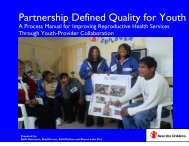

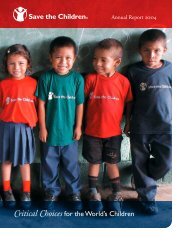
![View full document [PDF 3.39 MB] - PreventionWeb](https://img.yumpu.com/27308954/1/190x245/view-full-document-pdf-339-mb-preventionweb.jpg?quality=85)
